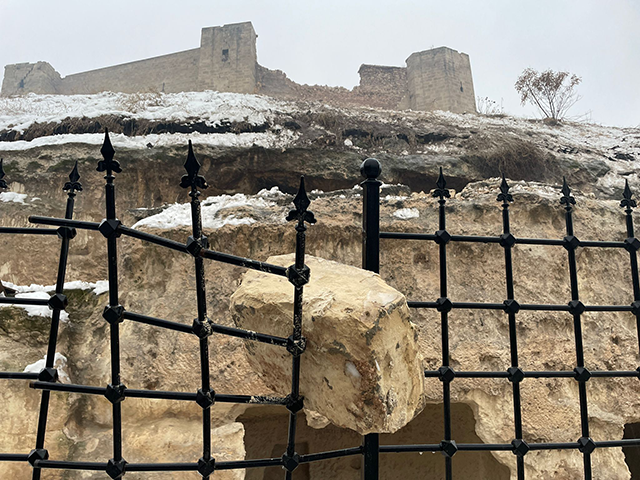The United Nations Educational, Scientific, and Cultural Organization (UNESCO) announced on Tuesday that it will provide assistance to preserve World Heritage sites in Turkey and Syria that were damaged by Monday’s devastating earthquakes.
UNESCO’s World Heritage List includes natural and man-made locations around the world that are deemed to hold outstanding cultural, historic, or environmental significance.
One badly damaged historic site is Gaziantep Fortress in southeastern Turkey, located near the epicenter of the earthquakes. The 2,000-year-old structure was important to the Hittite, Roman, Byzantine, and Ottoman Empires. At the time of the earthquakes, it was the site of the Gaziantep Defense and Heroism Panoramic Museum.
2,200 years old Gazintap Castle destroyed by the earthquake in Turkey.
Before vs Now. pic.twitter.com/vAtIWhmlsA
— Xavi Ruiz (@xruiztru) February 6, 2023
Various accounts describe Gaziantep Fortress as either severely damaged or destroyed by the quake, a distinction that can probably only be resolved by carefully studying the shaken castle to determine how much of it can be safely preserved or restored.
According to Turkish media reports, several of Gaziantep’s many towers and some of its distinctive iron railings were destroyed in the quake, with debris scattered onto nearby roads and sidewalks. One wall of the fortress collapsed completely, and massive cracks formed in other parts of the structure.
Turkish media also reported that the dome and eastern wall of the Sirvani Mosque, a 17th-century structure next to the castle, have partially collapsed.
UNESCO said on Tuesday it was saddened by the damage to the city of Diyarbakir, which is home to a World Heritage site called the Diyarbakir Fortress and Hevsel Gardens. The fortress site includes the ancient city walls of Diyarbakir, which are almost six kilometers in length. The Hevsel Gardens link Diyarbakir to the Tigris River and were historically a source of food and water for the city.
UNESCO said it was “particularly concerned” about damage to the ancient city of Aleppo, Syria, a site already jeopardized by the long-running Syrian civil war.
Syria's ancient Aleppo citadel, considered to be one of the oldest and largest castles in the region, was heavily damaged in Monday's initial quakehttps://t.co/rms4qbZej2
— Middle East Eye (@MiddleEastEye) February 7, 2023
Aleppo, which also dates back to the Hittite era, includes a mosque built in the 12th Century, a castle built in the 13th Century, and numerous historic structures over 400 years old. The city includes everything from Roman streets to 6th Century Christian buildings and Ottoman Empire palaces.
“Significant damage has been noted in the citadel. The western tower of the old city wall has collapsed and several buildings in the souks have been weakened,” UNESCO reported on Tuesday.
“Other sites on the World Heritage List not far from the epicenter could be affected, such as Göbekli Tepe, Nemrut Dağ, and Tell of Arslantepe,” the statement warned, referring to a Mesopotamian city, a 2,000-year-old mausoleum, and a Hittite castle, respectively.
Göbekli Tepe boasts some of the world’s oldest megaliths, clocking in at roughly 10,000 years old. Mount Nemrut is one of Turkey’s most remote, but most compelling, tourist destinations.
Another historic location damaged by the quakes is the Yeni Cami Mosque in Turkey’s Eastern Anatolia region. The mosque was only just reopened last year after an extensive restoration. It was built on the site of an even older structure called the Haciyusuf Mosque, which was itself destroyed by an earthquake in 1984.
ভূমিকম্পের পর তুরস্কের মালাটায় ঐতিহাসিক ইয়েনি কামি মসজিদ ধ্বংস হয়ে গেছে।
Historic Yeni Cami Mosque In Malatya, #Turkiye Destroyed After Monday’s #Earthquake pic.twitter.com/WHwK4CRIQI
— Basherkella – বাঁশেরকেল্লা (@basherkella) February 6, 2023
British Council Global Director of Culture in Action Stephen Stenning optimistically told the National on Tuesday that the quakes might foster greater international cooperation to protect historic sites.
“This natural disaster will create a whole new level of need to look at the intangible cultural heritage of the peoples affected by the earthquake and also the sites and tangible heritage around it. There is more international co-operation on the area of cultural protection than there has been in the past, but there is the need for a lot more in the future,” he said.
“Things like this really draw attention and in a way help with that mission of a collective focus on the need to protect cultural heritage,” Stenning said.
On the other hand, Syrian dictator Bashar Assad decided the day after the earthquake would be a good time to bomb the rebellious town of Marea, an attack denounced as “truly callous and heinous” by British MP Alicia Kearns of the Foreign Affairs Committee, and “completely unacceptable” by British Foreign Secretary James Cleverly.
“Sadly it speaks to a long-standing pattern of behavior by the Assad regime, a regime that we condemn, have sanctioned and will continue to bring about sanctions – working with our international friends and partners – to try and prevent behavior like this occurring again,” Cleverly said.

COMMENTS
Please let us know if you're having issues with commenting.